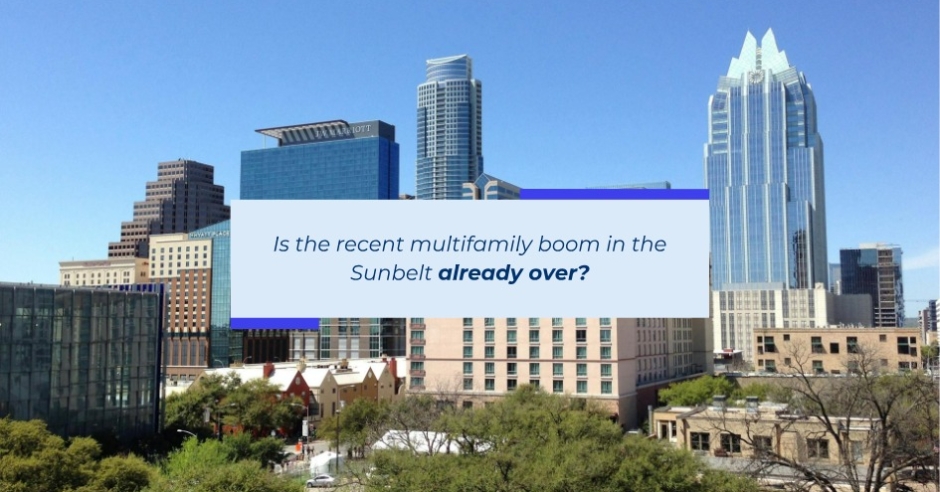Is the Sunbelt Multifamily Boom Already Over?
In the heady days of 2020 through early 2022, multifamily real estate deals in Sunbelt states—like Texas, Florida, Georgia, and Arizona—seemed almost bulletproof. Demand surged, population growth was robust, and interest rates sat near historic lows. Fast forward a few years, and suddenly many of these once-promising purchases are encountering significant challenges.
What happened? Why are these assets—acquired during what looked like a “golden era” for multifamily—now struggling? Below, we’ll explore some key factors contributing to the turmoil, drawing inspiration from recent industry conversations, including a lively Reddit discussion that highlights the common pitfalls investors have faced.
1. Rising Interest Rates and Refinancing Woes
The Low-Rate Honeymoon Ended
Between 2020 and early 2022, borrowing costs were incredibly attractive. Many investors took out loans or bridge financing with the assumption that they’d be able to refinance at similarly low rates—or simply flip the property for a profit. However, by mid-to-late 2022, the Federal Reserve began an aggressive campaign to hike interest rates to combat inflation.
Suddenly, buyers who assumed a permanent low-interest environment found themselves needing to refinance at rates far higher than they had underwritten. This pushed monthly debt payments up significantly, eroding cash flow and, in some cases, putting debt service coverage ratios into dangerous territory.
Short-Term Financing Time Bomb
A huge portion of properties purchased during that window relied on short-term, floating-rate bridge loans. Such loans often come with the risk of “rate caps,” or protective products that limit how high an interest rate can climb—yet many investors either neglected to buy these caps or underestimated how expensive they’d become. As those loans mature or require extension, some owners find it difficult to secure new, more affordable debt to replace the old financing.
2. Overoptimistic Rent Growth Projections
Pandemic-Era Rent Booms
In the early days of the pandemic, Sunbelt markets experienced a surge in population growth, thanks to higher inbound migration from the Northeast, Midwest, and West Coast. The result was rapid rent increases—sometimes double-digit growth over a single year.
Emboldened by these gains, many buyers believed rents would keep climbing at the same pace. Their underwriting assumptions included extraordinary year-over-year rent hikes to justify ever-increasing purchase prices. As economic conditions cooled and the post-pandemic reshuffling normalized, actual rent growth did not always match these lofty projections, putting properties under strain when income failed to meet underwriting targets.
3. Supply Outpacing Demand in Some Submarkets
Building Boom Backfires
Developers responded to high demand by launching new construction at a record pace, particularly in fast-growing Sunbelt metros such as Austin, Dallas, and Phoenix. In some cases, supply has now caught up—or even surpassed—demand.
While long-term growth prospects may still look solid, new properties hitting the market simultaneously creates downward pressure on rents and occupancy, especially for Class A and B multifamily. For owners who purchased older properties at premium prices, competition from brand-new buildings—offering attractive concessions—can erode net operating income (NOI) and slow rent growth.
4. Operating Expenses and Inflationary Pressures
Unexpected Cost Surges
Inflation isn’t just about interest rates. Everything from construction materials and renovation costs to insurance premiums and property taxes has jumped significantly in the past few years. Some Sunbelt states, like Texas, have notoriously high property taxes, and in an environment of skyrocketing valuations, tax bills can rise substantially.
Investors who budgeted for moderate or predictable expense growth may be facing sticker shock as operating costs rise faster than expected. In highly competitive markets where landlords can’t freely pass these costs to tenants through rent hikes, the burden falls directly on the asset’s bottom line.
5. A Shifting Investor Climate
Flight to Safety
Real estate—and multifamily in particular—was the darling of investors seeking stable returns during the uncertainty of COVID-19. But as the economic landscape changes, institutional and individual investors alike are re-evaluating their risk appetite. With higher returns available in alternative vehicles (like treasury bonds, which carry less risk), capital for real estate deals has become more selective.
Fewer potential buyers, combined with tougher lending standards from banks, means that owners looking to exit or refinance are stuck with a smaller pool of interested parties and more stringent loan terms. This can create a liquidity crunch when properties need a cash injection to cover renovations or debt service shortfalls.
6. Syndication Vulnerabilities
Limited Partner Pressures
A significant number of Sunbelt deals purchased during 2020-2022 were syndicated—financed with multiple limited partners (LPs) who pooled their resources. When revenue falls short and expenses rise, sponsors may come back to these LPs for additional capital calls. Such calls can lead to tension or even conflicts, especially if the property isn’t meeting pro forma expectations.
The Sponsor’s Dilemma
Some sponsors, particularly those who started in a booming market, may be less experienced with distressed situations. Their ability to navigate complicated loan modifications, partner negotiations, or restructuring is often untested. As these realities set in, properties can stumble due to a lack of strong asset management and contingency planning.
Final Thoughts
The Sunbelt’s rapid population growth and business-friendly environment still offer strong long-term tailwinds for multifamily real estate. Yet the period of 2020-2022 created a perfect storm of low interest rates, high investor demand, and optimistic underwriting that many deals can’t sustain in today’s higher-rate, inflationary landscape.
For owners, sponsors, and investors caught in this squeeze, there’s no easy fix—only a hard lesson in disciplined underwriting, more prudent financing choices, and the need for robust contingency plans. While it may be a turbulent time for many of these recent acquisitions, carefully recalibrating expectations and financing strategies can help restore stability and set the stage for healthy, more sustainable growth in Sunbelt multifamily markets.






